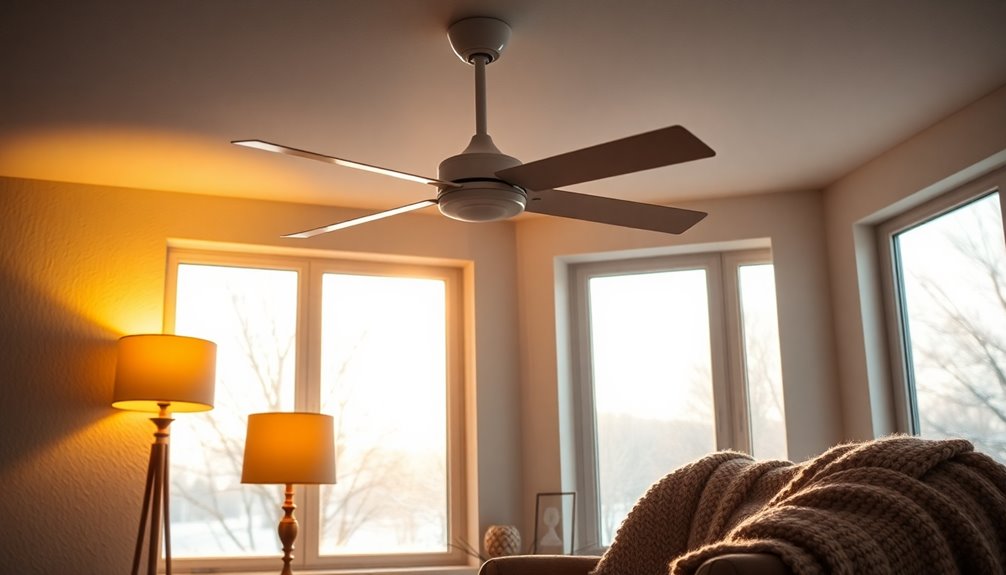To stay warm in winter, set your ceiling fan to rotate clockwise. This creates an updraft, pulling cold air up and pushing warm air down into your living space. Make sure to run it on low speed for ideal circulation. This simple adjustment can help eliminate cold spots and lower your heating bills by up to 15%. It also eases the workload on your heating system, enhancing overall efficiency. So, don't overlook the benefits of your ceiling fan; there's more you can do to maximize comfort and energy savings as the colder months approach.
Key Takeaways
- Set your ceiling fan to rotate clockwise to create an updraft, pushing warm air down to stay warm in winter.
- Operate the fan at low speed to gently mix warm air without creating a chilling breeze.
- Position the fan 8 to 9 feet above the floor for optimal air circulation and efficiency.
- Regularly maintain your heating system and insulate your home to enhance overall warmth and efficiency.
- Using a ceiling fan can reduce heating costs by up to 15% by allowing lower thermostat settings.
Understanding Ceiling Fan Direction
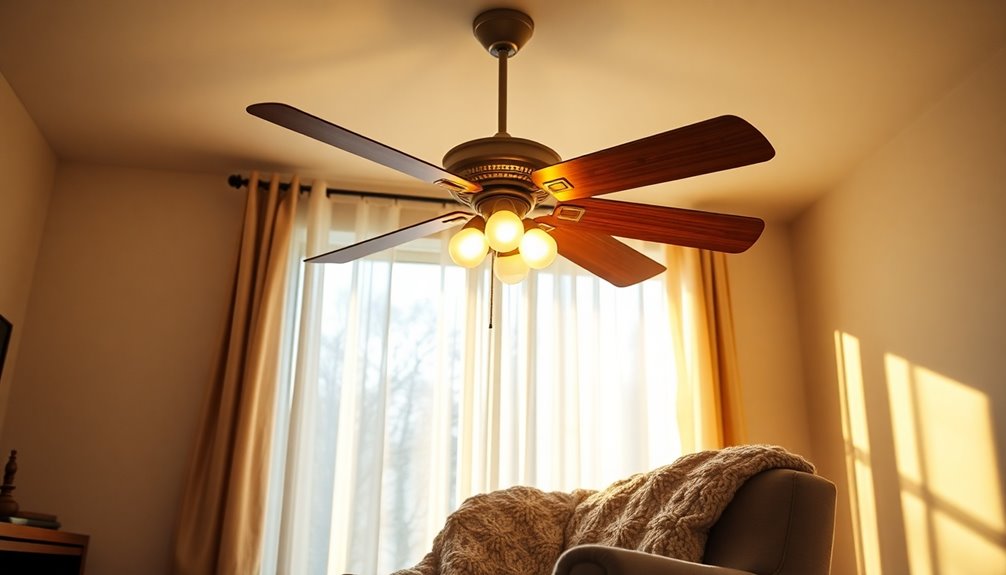
How can you make the most of your ceiling fan in different seasons? Understanding the direction of your ceiling fan is key to maximizing its effectiveness.
In winter, set your fan to spin clockwise. This creates an updraft that pulls cold air up and pushes warm air down, helping to evenly distribute heat throughout the room. Operate it on low speed for the best results. Additionally, using Energy Star-certified models can enhance efficiency and save on energy costs while keeping your home warm. Installing a heat pump can further optimize your home's heating system during the colder months.
To switch directions, look for the switch on the fan body or remote control. Remember to check the fan's direction during Daylight Savings Time changes in spring and fall.
Using the right fan size also boosts air circulation, making your home cozier while potentially lowering energy costs.
Functionality of Ceiling Fans in Winter
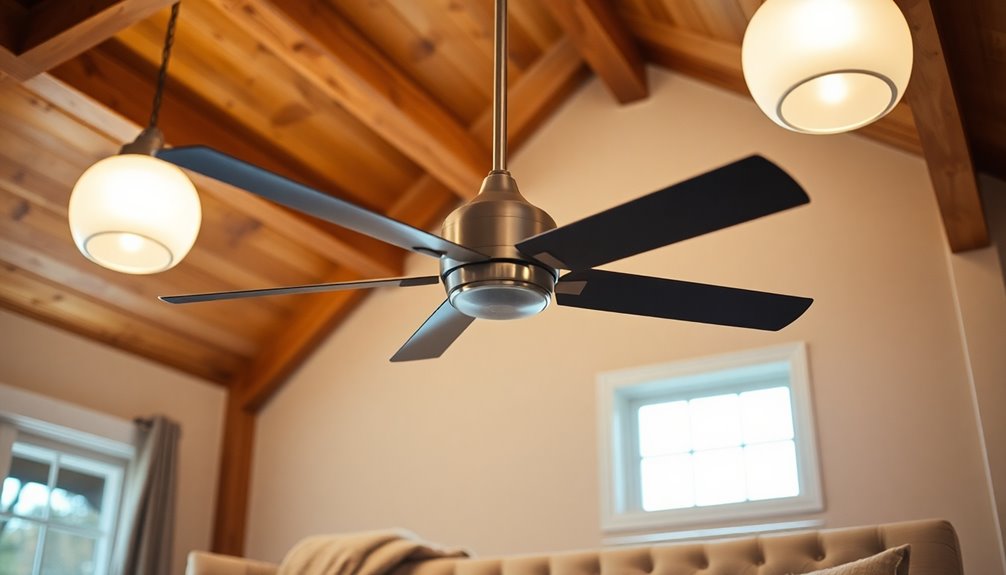
While you might think of ceiling fans as a summer necessity, they play an essential role in winter as well. By rotating clockwise, ceiling fans help redistribute warm air that naturally rises to the ceiling. This movement eliminates cold spots and prevents downdrafts, ensuring a more comfortable environment. You can lower your thermostat settings while enjoying a consistent temperature throughout your space, leading to energy savings of over 15 percent. This is because the reverse function efficiently circulates warm air accumulated on ceilings. Simply set your fan to the lowest speed and check the direction to confirm it's creating a gentle updraft. This simple adjustment not only enhances heating efficiency but also keeps your room cozy without straining your heating system. Embrace your ceiling fan this winter for ideal warmth!
Advantages of Winter Ceiling Fan Use
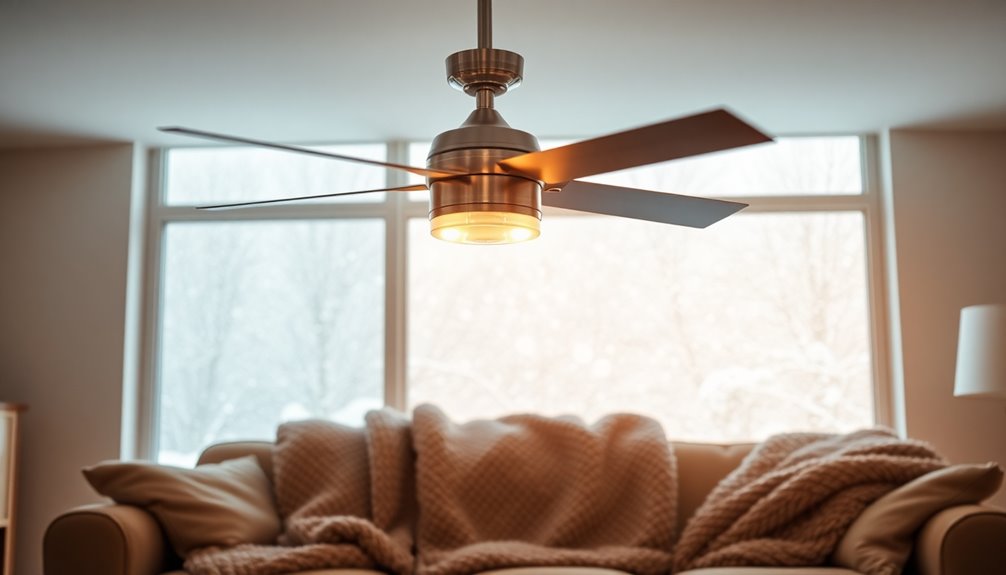
One of the key advantages of using ceiling fans in winter is their ability to improve air circulation throughout your space. By redistributing warm air trapped near the ceiling, ceiling fans eliminate cold spots, ensuring a consistent and comfortable room temperature. This enhanced air movement not only makes your space feel warmer, but it also helps regulate humidity levels, reducing the risk of mould and mildew. Additionally, ceiling fans can lower heating costs by allowing you to maintain a lower thermostat setting without sacrificing comfort. They ease the workload on your heating system, promoting energy efficiency and extending its lifespan. Moreover, using ceiling fans in reverse mode can significantly enhance overall warmth in your home by pushing the warm air down into living spaces.
Best Winter Fan Settings
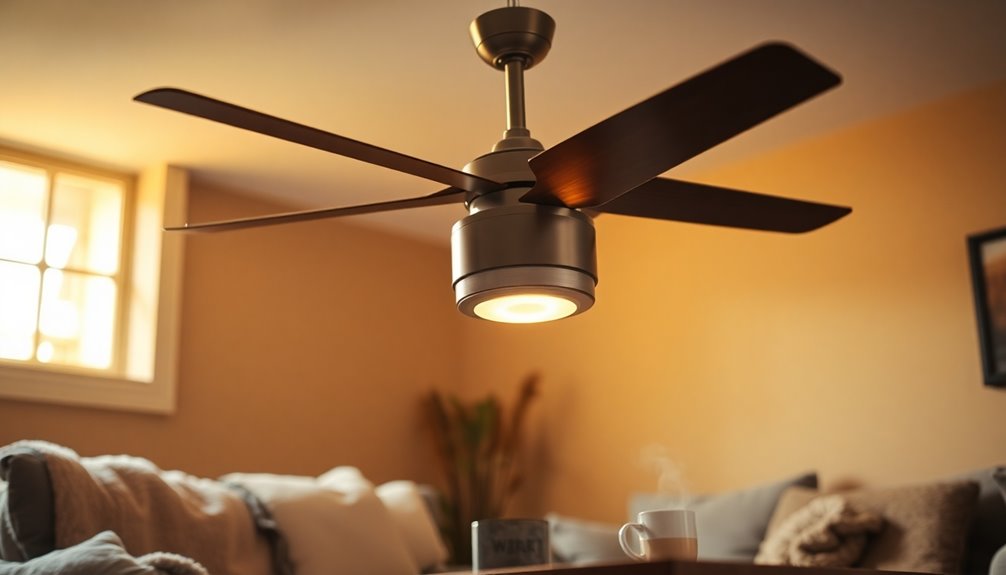
To maximize the benefits of your ceiling fan during winter, it's important to set it up correctly.
Start by ensuring your fan rotates clockwise when viewed from below. This creates an updraft, pulling cooler air upward and pushing warm air down into your living space. Operating the fan at low speed is vital; it gently mixes warm air without creating a chill. Aim for central placement, about 8 to 9 feet above the floor, to optimize air circulation. Additionally, using ceiling fans in winter can reduce heating bills by up to 15% in winter, making them a cost-effective solution for maintaining warmth.
Avoid obstructions that can impede airflow. If your fan has additional features like reversible motors or remote controls, use them to adjust settings easily.
Following these tips will enhance warmth and comfort while saving on energy costs.
Tips for Enhanced Heating Efficiency
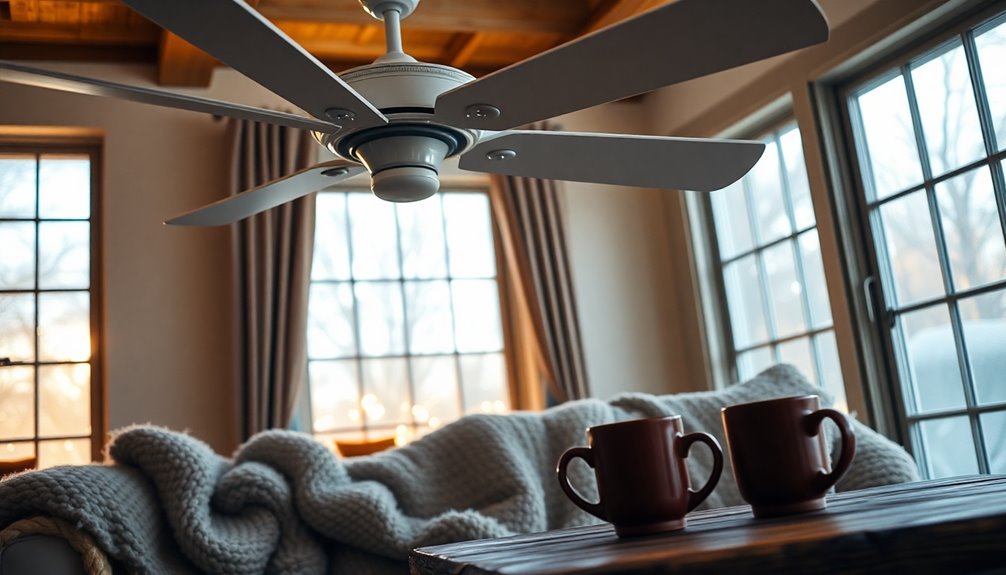
Enhancing heating efficiency in your home can considerably lower energy bills and improve comfort during the colder months.
Start by using a programmable thermostat; set it 7-10 degrees lower when you're away or sleeping. This automation optimizes heating cycles, ensuring warmth just before you return.
Next, insulate your home thoroughly. Check your attic, seal drafts, and consider adding insulation to walls and ceilings. Don't forget to protect pipes from freezing; good insulation minimizes heat loss, keeping your space cozy. Regular maintenance of your heating system can also increase overall efficiency of the refrigeration cycle, contributing to a warmer home.
Switching to LED light bulbs can also help; they use 75% less energy and last much longer.
Finally, utilize your ceiling fans by setting them to rotate clockwise at a low speed, distributing warm air effectively throughout the room.
These simple steps can enhance your heating efficiency considerably.
Frequently Asked Questions
Can Ceiling Fans Be Used With Central Heating Systems?
Yes, you can use ceiling fans with central heating systems. Just make sure your fan's compatible with your thermostat.
When winter hits, set the fan to rotate clockwise at a low speed to help circulate warm air throughout the room. This gentle updraft pushes warm air down, keeping your space cozy.
How Often Should I Run My Ceiling Fan in Winter?
You should run your ceiling fan in winter whenever you're in the room to maximize warmth.
Set it to low speed and switch the direction to clockwise. This pulls warm air down from the ceiling, distributing it evenly without creating a chill.
If you leave the room, turn the fan off to save energy, since it only circulates air without changing the room's temperature.
Regular maintenance also keeps it running efficiently.
Do Ceiling Fans Work Better in Large or Small Rooms?
Ceiling fans work best in large rooms, where they can move more air effectively without overwhelming the space.
In smaller rooms, a large fan might create excessive airflow, making it feel drafty. Instead, you should opt for smaller fans that circulate air efficiently and maintain comfort.
They also fit better proportionally, ensuring aesthetic balance while providing targeted airflow to keep every corner cozy and inviting.
Are There Specific Fan Models Better for Winter Use?
Yes, there are specific ceiling fan models that work better for winter use.
Look for fans with reversible blades, like the Hunter Builder or Minka-Aire Barn, which circulate warm air effectively.
Choose models that operate quietly on low speeds to avoid drafts.
Brands like Harbor Breeze also offer energy-efficient designs, while ensuring easy installation.
Can Ceiling Fans Help Reduce Humidity in Winter?
Ceiling fans don't really reduce humidity in winter; they primarily circulate air.
While this can help evaporate moisture, it's more effective in warmer months. In winter, focus on managing indoor humidity levels, perhaps using a humidifier to maintain comfort.
Sealing drafts and using a programmable thermostat can also help.
Conclusion
In winter, setting your ceiling fan to run clockwise can make a big difference in keeping your space cozy. This direction helps circulate warm air that rises to the ceiling, pushing it back down where you need it. By utilizing your ceiling fan wisely, you can enhance your heating efficiency and save on energy costs. So, don't overlook this simple trick—adjust your fan settings and enjoy a warmer, more comfortable home this winter!
